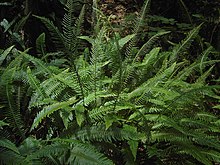| Struthiopteris spicant | |
|---|---|

| |
| Scientific classification | |
| Kingdom: | Plantae |
| Clade: | Tracheophytes |
| Division: | Polypodiophyta |
| Class: | Polypodiopsida |
| Order: | Polypodiales |
| Suborder: | Aspleniineae |
| Family: | Blechnaceae |
| Genus: | Struthiopteris |
| Species: | S. spicant
|
| Binomial name | |
| Struthiopteris spicant (L.) F.W.Weiss
| |
| Synonyms[1][2] | |
|
Synonyms
| |
Struthiopteris spicant, syn. Blechnum spicant, is a species of fern in the family Blechnaceae, known by the common names hard-fern[3] or deer fern. It is native to Europe, western Asia, northern Africa, and western North America.[1][4] Like some other species in the family Blechnaceae, it has two types of leaves. The sterile leaves have flat, wavy-margined leaflets 5 to 8 millimeters wide, while the fertile leaves have much narrower leaflets, each with two thick rows of sori on the underside.[5]
The Latin specific epithet spicant is of uncertain origin, possibly referring to a tufted or spiky habit.[6]
S. spicant is hardy down to −20 °C (−4 °F) and evergreen, growing to 0.5 m (1 ft 8 in).[7] It has gained the Royal Horticultural Society's Award of Garden Merit.[8]
The species was first described in 1753 by Carl Linnaeus as Osmunda spicant. It has been placed in a wide range of genera, including Blechnum (as Blechnum spicant).[1] In the Pteridophyte Phylogeny Group classification of 2016 (PPG I), it is placed in the genus Struthiopteris, in the subfamily Blechnoideae.[9]
-
A sterile leaf
-
A fertile leaf with sori
- ^ a b c Cite error: The named reference
POWO_30079143-2was invoked but never defined (see the help page). - ^ Cite error: The named reference
GaspDittSmitSali16was invoked but never defined (see the help page). - ^ BSBI List 2007 (xls). Botanical Society of Britain and Ireland. Archived from the original (xls) on 2015-06-26. Retrieved 2014-10-17.
- ^ Cite error: The named reference
usdawas invoked but never defined (see the help page). - ^ Cite error: The named reference
jepsonwas invoked but never defined (see the help page). - ^ Harrison, Lorraine (2012). RHS Latin for Gardeners. United Kingdom: Mitchell Beazley. ISBN 978-1845337315.
- ^ RHS A-Z encyclopedia of garden plants. United Kingdom: Dorling Kindersley. 2008. p. 1136. ISBN 978-1405332965.
- ^ "RHS Plant Selector - Blechnum spicant". Retrieved 15 April 2020.
- ^ Cite error: The named reference
PPGIwas invoked but never defined (see the help page).



